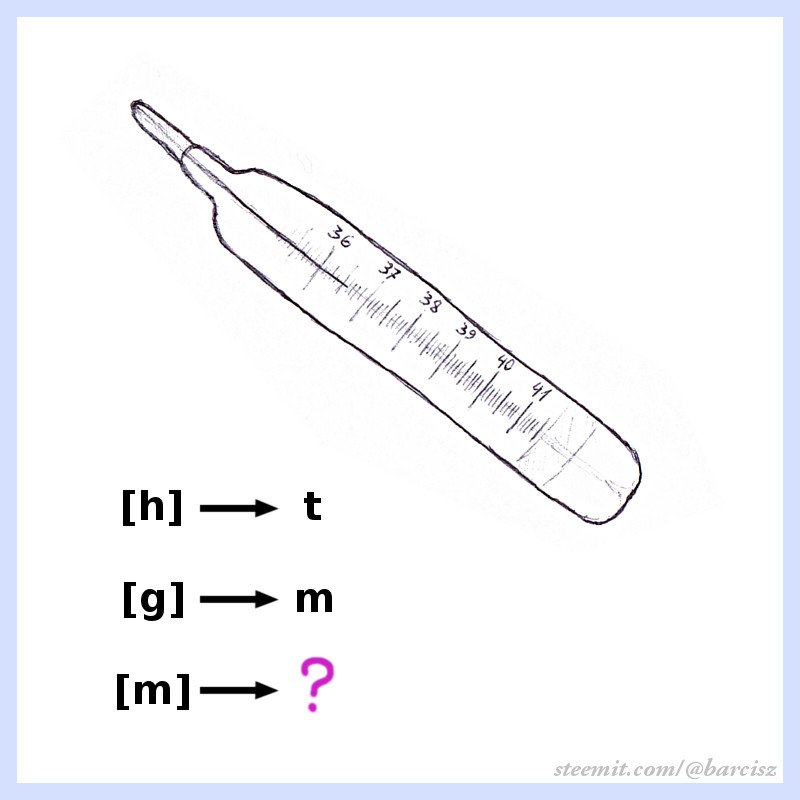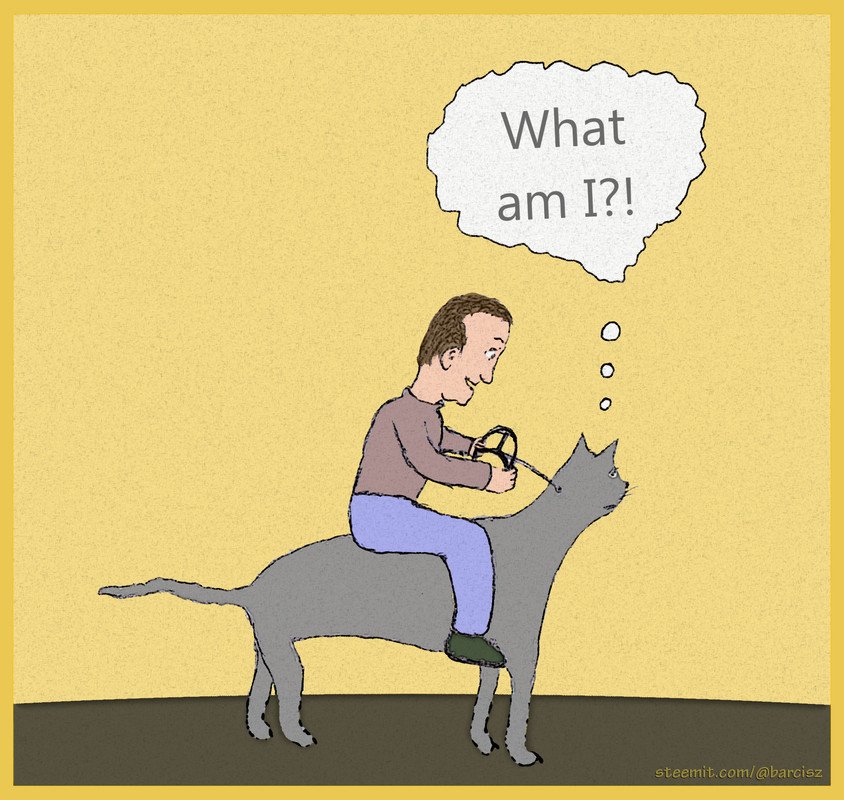Hi! This post is for all the rebus enthusiasts and, hopefully, for some future rebus fans. I will tell you what rebus puzzles are, by discussing a few examples created by me. It can be a helpful tutorial for the participants of my rebus contest series, which started with this puzzle.
We can consider rebuses as creative word puzzles where words or their parts are represented by pictures. Creative in a broader sense means that this form is quite open and authors of rebuses can shape it by incorporating new ideas into their puzzles.
I took a fresh look on Polish rebuses published on my fanpage (gathered in this album) and it turns out that some of them can be presented as English rebuses without any change. So I'll use a few of them as my examples and I'll present one completely new rebus – especially for Steemit readers. 🙃
Demonstrational example
My first example is from my fanpage and it's based on the association of words in a somewhat absurd image I drew. You have to know the Polish pop culture very well to solve it, so if you don't, just look at the picture and scroll down to the solution.

The answer of this rebus is "disco polo". It's a kitschy Polish dance music style that brings some wacky folklore to most of the weddings in our country and makes Haddaway's What Is Love feel like Beethoven. If you want to hear what it is, I give you a good example below, but don't torture yourself, if you're not a fan (I know I'm not) – just watch enough to satisfy your curiosity.
The image shows a polo player on some kind of disc instead of a horse, so if you're aware of the existence of the disco polo phenomenon, you can manage to guess it. But I'm not saying it's easy. It's a medium level or maybe even a little harder. My next three examples will have easy, medium and hard level, but don't attach yourself too much to these guides, as it's my subjective opinion. What's easy and what's hard for you is a matter of your individual knowledge, creativity and other skills.
The puzzles below require only common knowledge, so you can try to guess them if you want to. In such case, don't scroll down, as the solution will be given below each of them.
EASY
This is the premiere rebus – I assembled it from public domain images especially for Steemians. 🙂

This rebus provides the most common tricks you need to know to solve easy rebuses. The first picture is a pictogram and it represents the word I with an image of an eye – as they are pronounced in the same way. The instruction in the second picture is very common in rebuses. It tells you to replace one letter with another. So we replace the O in dog to get the word dig. The third picture brings another very common instruction – removing of letters. We remove F and S of the word fist to get it. The answer of the rebus is "I dig it" – and from the look of the dog in the picture we can say that it digs it too. 😉
MEDIUM

This rebus is quite similar to the demonstrational "disco polo" example. It's also based on the association of words in an absurd drawing of mine. Its official answer is "teleport", as it's literally a sea port that is also a telephone. The alternative answer could be something like a telephone line port or just any port that has something to do with telephones. And it's a perfect time to note that rebuses, as creative puzzles, can have alternative solutions – and I, as an author, was often surprised by the creativity of the audience of my riddles. But as my contest should have clear rules, I also have to note that in every edition the official answer is required to become a winner.
HARD
This is another rebus from my fanpage that can be solved both in Polish and in English, but it's specifically American English in this case (it matters!).

I can assure you that someone eventually guessed the correct answer on my fanpage, but this one is very hard. It's an example of incorporating a different kind of riddle into a rebus. On the right we have physical quantities and on the left, in square brackets, we have their units. Arrows represent a classic replacement instruction. So I put the first two lines only to demonstrate the idea of what these letters are – and it's not an easy riddle on its own. The third line is the real instruction. It tells us to replace [m] – meter (British English metre doesn't work so well) with a quantity associated with this unit, which is S (distance). We do the replacing in the word thermometer, so the answer is "thermos".
I hope you liked my examples. In my opinion rebus is a form of art, but of course you can have a masterpiece or a disco polo of rebuses. I hope I'm at least somewhere in the middle with my creations. Rebuses are quite subtle compared to memes with their flashy letters. They're also more subtle than popular humoristic and creative images, that are quite similar to rebuses, but they don't let the audience do the thinking, but have the "solution" written on the picture (the second of the images below is an example).
So tell me, which one do you like more? This:

Or this:

And my question doesn't have any judgment attached to it – as I hope that both can be appreciated in their own way. The first image is a rebus that I published on Steemit before and the second is the remake I created for this article. I'm curious about your opinions.
See you at the second contest of my rebus series! Follow me to be sure that you won't miss it. 😋
My other posts you might be interested in:

